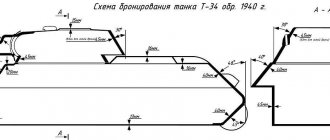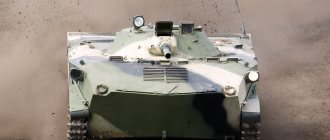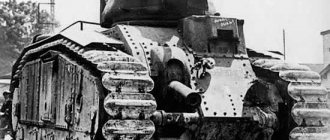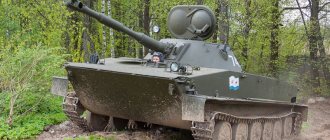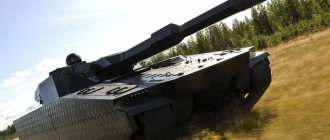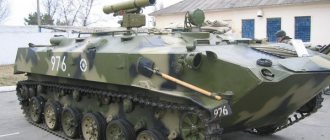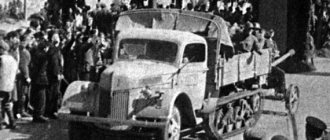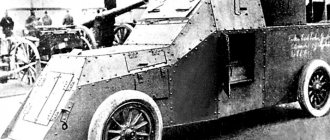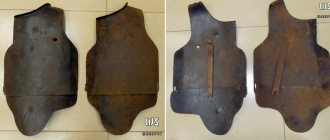Armor is a protective material characterized by high stability and resistance to external factors that threaten deformation and violation of its integrity. It doesn’t matter what kind of protection we are talking about: be it knightly armor or the heavy coating of modern combat vehicles, the goal remains the same - to protect from damage and take the brunt of the blow.
Homogeneous armor is a protective homogeneous layer of material that has increased strength and has a uniform chemical composition and identical properties throughout its entire cross-section. It is this type of protection that will be discussed in the article.
History of the armor
The first mentions of armor are found in medieval sources, we are talking about armor and shields of warriors. Their main purpose was to protect body parts from swords, sabers, axes, spears, arrows and other weapons.
With the advent of firearms, it became necessary to abandon the use of relatively soft materials in the manufacture of armor and move to more durable alloys that are resistant not only to deformation, but also to environmental conditions.
Over time, decorations used on shields and armor, symbolizing the status and honor of the nobility, began to become a thing of the past. The shape of armor and shields began to be simplified, giving way to practicality.
In fact, all world progress has come down to a speed race in the invention of new types of weapons and protection against them. As a result, simplifying the shape of the armor led to lower cost (due to the lack of decoration), but increased practicality. As a result, armor became more affordable.
Iron and steel found further use when the quality and thickness of armor became paramount. The phenomenon found a response in shipbuilding and mechanical engineering, as well as in strengthening ground structures and sedentary combat units such as catapults and ballistae.
Types of armor
With the development of metallurgy in historical terms, improvements in the thickness of shells were observed, which gradually led to the emergence of modern types of armor (tank, ship, aircraft, etc.).
In the modern world, the arms race does not stop for a minute, which leads to the emergence of new types of protection as a means of countering existing types of weapons.
Based on the design features, the following types of armor are distinguished:
- homogeneous;
- reinforced;
- mounted;
- spaced out.
Based on application methods:
- body armor - any armor worn to protect the body, and it does not matter whether it is the armor of a medieval warrior or the body armor of a modern soldier;
- transport - metal alloys in the form of plates, as well as bulletproof glass, the purpose of which is to protect the crew and passengers of the equipment;
- ship - armor for protecting ships (underwater and surface);
- construction - a type used to protect pillboxes, dugouts and wood-earth firing points (bunkers);
- space - all kinds of shock-proof screens and mirrors to protect space stations from orbital debris and the harmful effects of direct sunlight in outer space;
- cable - designed to protect submarine cables from damage and durable operation in aggressive environments.
Smart welding
0
An important contribution to the success of mastering the armor production of IS series tanks was made by automatic submerged arc welding of steel. Since it was impossible to transfer the entire process of manufacturing a tank armored hull to such welding at the beginning of 1944, engineers focused on automating the most extensive and mechanically loaded seams. At Chelyabinsk plant No. 200, during the assembly of the hull of the IS-2 heavy tank, only 25% of all welds could be automated. By mid-1944, Tankograd managed to automate 18% of all possible 25% of welds. The total length of welds along the hull of the IS-2 heavy tank was 410 linear meters, of which 80 linear meters were carried out by automated welding.
0
This result led to significant savings in scarce resources and electricity. It was possible to release up to 50 qualified manual welders (their labor costs amounted to 15,400 man-hours) and save 48,000 kilowatt-hours of electricity. The consumption of electrodes (about 20,000 kg, austenitic – 6,000 kg) and oxygen (by 1,440 cubic meters) has decreased. The time required for welding work has also been significantly reduced. For example, welding the bottom and turret box to the sides with a sixteen-meter seam took 9.5 man-hours manually, and only 2 with an automatic welding machine. A seam of similar length connecting the bottom to the sides of the tank hull required 3 man-hours in automatic mode ( in manual immediately 11.4). At the same time, highly qualified welders could be replaced in automatic welding by low-skilled workers.
Armor homogeneous and heterogeneous
The materials used to make armor reflect the development of outstanding design ideas of engineers. The availability of minerals such as chromium, molybdenum or tungsten allows the development of high-strength samples; the absence of such creates the need to develop narrowly targeted formations. For example, armor plates that could easily be balanced in terms of price and quality ratio.
According to its purpose, armor is divided into bulletproof, projectile-proof and structural. Armor, whether homogeneous (made of the same material over the entire cross-sectional area) or heterogeneous (varies in composition), is used to create both bulletproof and projectile-proof coatings. But that's not all.
Homogeneous armor has both the same chemical composition over the entire cross-sectional area and identical chemical and mechanical properties. Heterogeneous steel can have different mechanical properties (steel hardened on one side, for example).
Secret of success
0
The secret of the success of metallurgists lies in the study of the parameters of the formation of fibrous fracture of armor - the main parameter of projectile resistance. It turned out that you can do without a significant proportion of alloying elements by simply changing the cooling rate of the armor during hardening. But this is all simple in words - only the now classified archives can tell how many preliminary experiments and meltings the metallurgists had to do. At the Magnitogorsk Iron and Steel Works in 1941, the first prototypes of 49C steel were produced, which were not inferior to traditional “pre-war” armor. In particular, shelling with a 76-mm cannon showed full compliance with the tactical requirements for the tank. And since 1942, the KV series was equipped with armor only with the name 49C. It is worth remembering that the consumption of chromium, molybdenum and nickel has significantly decreased.
0
The search for new armor recipes for heavy equipment did not end there. In 1942, GD-63-3 steel was “welded”, completely devoid of scarce chromium and nickel. To some extent, nickel was replaced by manganese - its share increased more than three times (to 1.43%). Prototypes of the new armor were fired upon. And they turned out to be quite suitable for mass use in the design of HF. But the tanks themselves with medium-hard armor “Klim Voroshilov” were retired. And the place of heavy vehicles was taken by Joseph Stalin vehicles with high-hardness armor.
Rolled homogeneous armor
According to the manufacturing method, armor coatings (whether homogeneous or heterogeneous armor) are divided into:
- Rolled. This is a type of cast armor that has been processed on a rolling machine. Due to compression on the press, the molecules move closer to each other, and the material is compacted. This type of heavy-duty armor has one drawback: it cannot be cast. Used on tanks, but only in the form of smooth plates. On a tank turret, for example, a rounded one is required.
- Cast. Accordingly, less durable in percentage terms than the previous version. However, such a coating can be used for tank turrets. Cast homogeneous armor will, of course, be stronger than heterogeneous armor. But, as they say, a spoon is good for dinner.
Magnitogorsk recipes
0
See all photos in the gallery
In the previous part of the story we talked about cast high-hardness 70L armor used for the turrets of IS tanks. This was not the first experience of armor developers from TsNII-48 creating protection for heavy tanks. Before the Kursk Bulge, which became a catalyst for the development of domestic heavy tank building, the main object of modernization was the KV tank. Initially, all work was aimed at reducing the share of scarce alloying additives in the armor composition. Even the name at TsNII-48 came up with an appropriate name - low-alloy steel. The original FD-7954 armor, with which the KV tank entered the Great Patriotic War, contained, according to technical requirements, up to 0.45% molybdenum, 2.7% nickel and chromium.
0
By the end of 1941, a group of researchers led by Andrei Sergeevich Zavyalov at the Armor Institute created a recipe for FD-6633 or 49S steel, in which molybdenum required no more than 0.3%, chromium - up to 2.3%, and nickel - up to 1 ,5%. Considering that about 4 thousand copies of the KV series tanks were assembled from the second half of 1941 to 1943, one can imagine the volume of real savings in alloying metals.
×
Purpose
If we consider bulletproof protection against conventional and armor-piercing bullets, as well as the impact of fragments of small bombs and shells, then such a surface can be presented in two versions: rolled homogeneous armor of high strength or heterogeneous cemented armor with high strength on both the front and back sides.
Anti-ballistic (protects against the impact of large projectiles) coating is also available in several types. The most common of them are rolled and cast homogeneous armor of several strength categories: high, medium and low.
Another type is rolled heterogeneous. It is a cemented coating with hardening on one side, the strength of which decreases with depth.
The thickness of the armor in relation to hardness in this case is a ratio of 25:15:60 (outer, inner, back layers, respectively).
Chemical composition
0
What was the 51C rolled armor that became the main armor for the IS-2, ISU-122 and ISU-152? This is a deeply hardening steel for large armor thicknesses, having the following chemical composition (%): C 0.18–0.24 Mn 0.70–1.0 Si 1.20–1.60 Cr 1.0–1.5 Ni 3.0–3.8 Mo 0.20–0.40 P ≤0.035 S ≤0.035. Compared to cast armor 70L, rolled steel 51C had a higher proportion of molybdenum and nickel, which guaranteed an increase in hardenability to 200 mm. When the hulls of heavy tanks were fired with 88mm shells, it turned out that high-hardness armor was far superior to its medium-hard predecessors in durability. The issue of installing 51C rolled armor was resolved immediately.
Application
Russian tanks, like ships, are currently covered with chromium-nickel or nickel-plated steel. Moreover, if during the construction of ships a steel armor belt with isothermal hardening is used, then the tanks are covered with a composite protective shell, which consists of several layers of materials.
For example, the frontal armor of the Armata universal combat platform is represented by a composite layer, impenetrable to modern anti-tank projectiles of up to 150 mm caliber and sub-caliber arrow-shaped projectiles of up to 120 mm caliber.
Anti-cumulative screens are also used. It's hard to say whether this is the best armor or not. Russian tanks are improving, and with them the protection is improving.
Ural SAGs
0
A researcher of the Soviet tank industry, Candidate of Historical Sciences Vasily Vladimirovich Zapariy from the Institute of History and Archeology of the Ural Branch of the Russian Academy of Sciences in one of his works describes in great detail the automatic welding units used in the Urals for armored hull production. The most common was the ACC type machine gun with a Bushtedt head. In total, Uralmash had eight such installations. The wire feed speed in this machine depended on the voltage in the arc. It required 5 units, including 3 kinematic electric motors and 1 motor-generator. By mid-1943, the SA-1000 automatic welding machine was designed for the needs of IS-2 heavy tanks. Or an automatic welding machine with a power of up to 1000 A. In order to master the production of armored hulls for the new Chelyabinsk heavy tank IS-3, the plant's engineers designed the SG-2000 apparatus in 1944. This machine was designed to work with low-carbon welding wires of increased diameter (6–8 mm) and found its application in the manufacture of the IS-3 turret. The installation had a dispenser for introducing a special composition (various ferroalloys) into the weld section in order to deoxidize (restore) the metal in it. In total, based on the principle of self-regulation of the welding arc, by 1945 UZTM had created 9 auto-welding installations of three types: “SA-1000”, “SG-2000”, “SAG” (“Automatic Welding Head”).
Armor vs Projectile
Of course, it is unlikely that the members of the tank crew keep in mind the detailed tactical and technical characteristics of the combat vehicle, indicating what the thickness of the protective layer is and what projectile it will hold at what millimeter, as well as whether the armor of the combat vehicle they are using is homogeneous or not.
The properties of modern armor cannot be described by the concept of “thickness” alone. For the simple reason that the threat from modern projectiles, against which, in fact, such a protective shell was developed, comes from the kinetic and chemical energy of the projectiles.
Panther
The tiger is a powerful, but still rare weapon. The German army needed something more affordable for mass use. This is how the Panther appeared, around which there is still a lot of controversy to this day. But despite the budget, the characteristics turned out to be decent. Weighing 44 tons, it outperformed the T-34 in terms of mobility; on a good road it could travel at speeds of up to 60 km per hour. The Panther fired armor-piercing shells that could fly a whole kilometer in a second, and attacked the enemy at a distance of more than two kilometers.
The armor is quite powerful, its thickness in the front part is 60-80 mm, in the side part – up to 50 mm, in the lower part there were rollers in two rows for reinforcement on each side. But the angles of the armor reached 55 degrees. The location became a gap; the Panther did not outperform the T-34 in terms of protection; Soviet tanks hit it effortlessly.
Kinetic energy
By kinetic energy (it would be better to say “kinetic threat”) we mean the ability of a projectile blank to penetrate armor. For example, a projectile made of depleted uranium or tungsten carbide will pierce right through it. Homogeneous steel armor is useless against such hits. There are no criteria by which it can be stated that 200 mm homogeneous is equivalent to 1300 mm heterogeneous.
The secret to countering a projectile lies in the location of the armor, which leads to a change in the vector of the projectile’s impact on the thickness of the coating.
Mouse
Whether or not to include Mouses in the list of the thickest armored vehicles is a controversial issue. The fact is that only two of them were produced, and they were never able to enter the battlefield. However, they were still created. And if we compare the thickness of the protection, then each of this pair is an undisputed world leader. The thickness of the windshield is as much as 200 mm, which means that the car can withstand an impact of any force. The side armor width is not much less - 185 millimeters.
Now you won’t be able to see such a tank, since the Germans destroyed them when they retreated. But in the above-mentioned museum near Moscow you can look at a detailed model. It was compiled accurately according to the military chronicles of those years.
These were the thickest armored tanks built by Germany and the Soviet Union to fight in World War II. Now each of them is part of history, because it was they who made it in those days.
HEAT projectile
The chemical threat is represented by such types of shells as anti-tank armor-piercing high-explosive (according to the international nomenclature designated as HESH) and cumulative (HEAT).
A cumulative projectile (contrary to popular belief and the influence of the World Of Tanks game) does not contain a flammable filling. Its action is based on focusing the impact energy into a thin stream, which, thanks to high pressure rather than temperature, breaks through the protective layer.
Protection against this kind of projectiles is the build-up of so-called false armor, which absorbs the energy of the impact. The simplest example is the covering of tanks with chain-link mesh from old beds during World War II by Soviet soldiers.
The Israelis protect the hulls of their Merkavas by attaching steel balls to the hulls, hanging from chains.
Another option is to create reactive armor. When a directed jet from a cumulative projectile collides with a protective shell, detonation of the armor coating occurs. An explosion directed in opposition to the cumulative jet leads to the dispersion of the latter.
